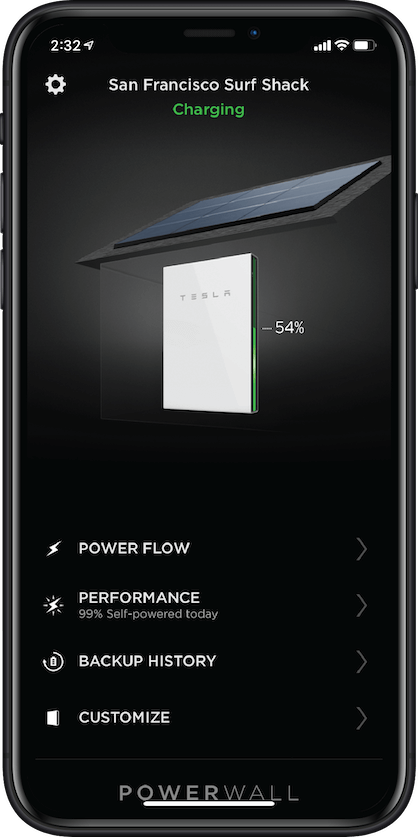Solar Panel Backup Storage & Tesla Powerwall
Maximize Your Savings

What is Solar Battery Backup Storage?
A home solar battery backup storage system is an innovative system that collects solar energy from your solar panels during the day that is not used in your home. This energy is stored in a battery that can be used to power your home at a time when energy from your solar panels is not available. This may be at night or during an emergency.
Why Secure Your Power?
When the Power Goes Out, How Do You…
- Work From Home?
- Power Medical Devices?
- Food Storage?
- Distance Learning?
- Charge Your iPhone/Laptop?
- Power Home Security Systems?
With each year having increasing wildfire power shutdowns, grid infrastructure failures, and more people working from home and spending time at home with family than ever before, a Battery Backup System will make sure you never live without power whether you live in California, Florida, or anywhere else
Maximize Your Savings with a Solar Battery Storage System
In addition to protecting your home from blackouts, a battery backup storage system helps you take control of your energy usage all day long. This grants you the option to maximize your savings by utilizing 100% of your solar energy production during evening hours when your panels aren’t producing power. Many people use battery energy to power their homes in the morning before the sun rises, and at night, after the sun has set, when the solar panels have charged it all day.

Benefits of a Home Solar Battery Storage System
Having a solar panel system on your property is an excellent investment that will lower your energy bills and carbon footprint. However, backing it up with a home solar battery storage system takes your use of renewable energy to another level.
In addition to further reducing your energy bills, these batteries provide even greater energy security and qualify for incentives in many states, significantly reducing their cost. They also have a quieter operation, unlike noisy generators.
- Avoid High Utility Rates
- Virtually Eliminate Power Utility Bills
- Gain Immediate Access to Excess Power
- Energy Independence
- Total Control of Your System
- Mobile App for Easy Monitoring

Monitoring Energy Consumption
You can monitor your home energy system in real time using your Tesla app. From the home screen select ‘Power Flow,’ to see how the Tesla Powerwall is interacting with your home, the grid and your solar system (if applicable). From the ‘Power Flow’ screen, you can also select the bar chart icon to access the graph page and see more details and historical usage.
Mobile App Features
- Monitor Your Home Energy System
- Access Historical Usage
- Reserve for Power Outages
- Customize Settings and Preferences
- Set and Combine Modes
Combat Rolling Blackouts
Electricity companies throughout California have implemented planned blackouts to prevent wildfires on hot days by cutting back on energy use. You don’t have to find yourself in the dark at a time like this. Installing a solar battery backup storage system will allow you to power your home with your solar panels, no matter the weather or time of day.

Tesla Powerwall Installation
When you’re ready to install solar battery storage in your home, one of your best options is the Tesla Powerwall. This battery backup system stores excess electricity generated from your solar panels.
Each Tesla Powerwall is equipped with a rechargeable lithium-ion battery that provides approximately 13.5 kWh of energy, offering 7 kW at peak and 5 kW of continuous power. A single unit can start two large appliances simultaneously, such as a refrigerator, microwave oven, or heater.
So, how exactly does a Powerwall work, especially in places like California, where blackouts are common?
Solar energy systems usually shut down during power outages, even when the sun is shining. The shutdown keeps generated electricity flowing into the grid and hurts utility workers. But if you have solar battery storage like Tesla Powerwall, its Backup Gateway disconnects your system from the electric grid and provides power to your home through stored energy.
Grid failure is not the only time a Tesla Powerwall comes in handy. You can also use solar battery storage to power your home once the sun sets. With time-of-use rates in California and Florida, having solar batteries lets you optimize economic benefits by reducing your grid dependence. You can customize consumption based on preferences through the Tesla app.
FAQs
Will a Tesla Powerwall Work with a Generator?
Yes, it will. The Powerwall will turn on first during power outages to supply backup power. Then, the electrical load automatically shifts to your generator once its charge is depleted or consumption exceeds stored capacity.
However, solar batteries cannot be charged by a generator, only through solar panels. Moreover, they shouldn’t be connected directly to the generator but via an external automatic transfer switch.
Even though you have a backup generator, it doesn’t mean home solar battery storage is no longer necessary. It will, however, be less expensive to use solar energy for backup power instead of gas-powered standby generators.
Where Should Solar Batteries Be Stored?
The recommended location for Tesla Powerwall installation is inside your home, even though it is outdoor-rated. This is because non-living spaces like the garage or unfinished basement protect the solar battery storage system from elements that cause reduced functionality and deterioration. For instance, extreme outside temperatures may result in less-than-optimal performance.
How Long Can a Powerwall Power a House?
It depends on how you use your home solar battery storage. Running energy-intensive appliances like the dishwasher, air conditioner, heater, washer, and dryer will deplete a Powerwall’s charge quickly, especially when you use them for prolonged periods.
Another factor that can impact a Powerwall’s ability to power your home is the weather condition. For example, a sunny day can efficiently charge the solar battery, allowing you to have power longer.
How Long Does It Take to Charge a Powerwall?
Many factors affect a solar battery’s charging period, including the solar panel’s production output, weather, brightness, outside temperature, and shade. Given the right conditions—a bright, cloudless day with no shade on your 7.6 kW solar energy system—expect your Powerwall to be fully charged within two hours.
How Many Solar Batteries Are Needed to Power a House?
The size of your battery backup system will depend on your preference and usage. To put it into perspective, the average residential consumption is 30 kWh per day, but the usable capacity of a Tesla Powerwall is only 13.5 kWh. Consider installing multiple solar batteries if you’re a heavy energy user and want guaranteed power to survive prolonged grid failures.
It’s best to discuss your needs with the installer to understand how many Powerwall units you should get since it varies for every household.
If cost is holding you back from getting multiple solar batteries, keep in mind that the more Powerwalls that are purchased, the lower the price is per unit.
How Many Tesla Powerwalls Can I Have?
There is no limit to the number of solar batteries you can install in your home; it’s about finding the perfect balance between your electricity demands and the total capacity of the planned battery backup system.
How Often Do Home Batteries Need to Be Replaced?
The standard warranty of a Tesla Powerwall is 10 years at 70% storage capacity. However, a solar battery storage unit loses about 30% of its rated capacity in 10 years, and if the pattern continues, it deteriorates until it can no longer hold a charge.
Consider replacing your solar batteries once their storage capacities are insufficient for your needs. The interval can be shorter or longer than 10 years.
Speak to a Solar Expert for Free
You can speak with one of our Solar Experts in California or Florida today and get your questions answered regarding your solar battery backup system and your best solar strategy. We will share sound advice and recommendations that will show you maximum benefit.
And lastly, we’ll review your custom system design and details!
GET A QUOTE




